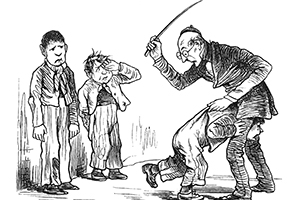
Author: Stacy W. Kish

During the holiday season when families gather together, a researcher with University of Utah Health wants to begin a conversation with parents about safe and effective ways to discipline children.
Spare the rod, spoil the child. This phrase, coined in the 17th century, continues to permeate American culture today. But while many communities are moving away from corporal punishment, it remains entrenched in others, codifying physical abuse into law.
In a recently published article in JAMA Pediatrics, a team of researchers from the University of Florida, Georgia State University, and Harvard University explored the correlation between the day a report card is released and reports of physical abuse. Their findings showed an increase in reports of physical abuse when a report card is issued on a Friday. Their conclusion release report cards earlier in the week, thereby preventing parents from stewing over the results during the weekend. For Antoinette Laskey, MD, this conclusion missed the point.
“Policy changes that try to ‘fix’ child abuse but fail to address the underlying cause of abuse does not solve the problem,” said Laskey, Chief of the Division of Child Protection and Family Health at University of Utah Health and Medical Director of the Center for Safe and Healthy Families at Primary Children’s Hospital. “Children are being beaten.”
Laskey responded to her peers in an editorial in the same issue of JAMA Pediatrics, published online on December 17.
What may be surprising is how prevalent corporal punishment remains in society today. In fact, 19 states allow physical discipline to be administered by school officials. Corporal punishment is any form of correction that involves physical punishment, including switching, spanking, caning, slapping, chastising, paddling, or flogging.
“The whole purpose of corporal punishment is to cause pain,” Laskey said. “Spanking can leave not only physical scars but also psychological injuries that can last a lifetime.”
Medical literature confirms that corporal punishment is harmful to a child’s development, shaping how a child thinks, feels, behaves and interacts with others. The news is not all bad. As a country, people are less inclined to use physical abuse to discipline children.
Laskey admits that parents spank for different reasons. For some, it is a quick way to get a child’s attention to prevent a dangerous result, like running into a heavily trafficked street. But others use this approach to teach a child a lesson.
“Parenting is hard. It doesn’t always work the way you expect it to,” Laskey said. “We need to be focused on how to help our children learn without physically harming them.”
According to Laskey, discipline has to be age dependent. She recommends parents remove the child from the situation to a safe place without stimuli. While your child is in time out, put yourself into time out too. As you calm down, consider ways to help your child understand what is happening.
“If you feel that this is the time to teach a child a lesson, then it is not the time to teach the lesson,” Laskey said. “Parents need a versatile skillset to change a child’s behavior, so spanking doesn’t seems like the easiest way.”
She suggests praising younger children when they do the right thing, while a conversation about the behavior may be more effective with older children. She cautions that words can also have consequences so consider your words carefully when having the conversation.
The American Academy of Pediatrics also developed pointers to help parents with discipline strategies to avoid physical or verbal punishment to stop unwanted behavior in children and teens.
- Praise good behavior.
- Be a role model for good behavior.
- Set limits and expectations.
- Ignore bad behavior or redirect a child away from bad behavior.
Additional resources are available for parents to promote healthy disciplinary approaches:
Bright Futures helps care givers provide well-child and adolescent care.
Healthy Children.org aims to provide optimal physical, mental, and social health and well-being for all infants, children, adolescents, and young adults.
CDC Positive Parenting Tips helps parents learn about child development and provide positive, safe parenting at each stage of the child’s life.
Connected Kids helps parents and families raise resilient children.